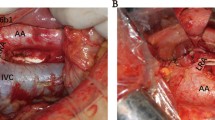Abstract
Background
The aim of this study was to determine how to select potential candidates for curative resection among advanced gastric patients with equivocal findings of para-aortic lymph node metastasis on computed tomography (CT).
Methods
We analyzed the clinicopathologic results of 23 advanced gastric cancer patients who were diagnosed as having equivocal findings of para-aortic lymph node metastasis on a CT scan and who underwent gastrectomy with D2 and para-aortic lymph node dissection.
Results
Twenty-two patients were male, and one patient was female. The median age of all study subjects was 52 years (range, 31–75 years). Sixteen underwent total gastrectomy, and seven underwent subtotal gastrectomy. The median number of A2 (suprarenal) lymph nodes harvested was 2 (range, 1–5), and that of B1 (infrarenal) lymph nodes was 6 (range, 1–17). Ten (43.5%) of the 23 patients were proven pathologically to have metastasis to para-aortic lymph nodes. Two patients with cT2 cancer had no metastatic para-aortic lymph node, whereas three patients with cT4 disease had metastatic para-aortic lymph nodes (P = .021). Seven (70.0%) of 10 patients with pathologic para-aortic lymph node metastasis experienced recurrence, whereas only 2 (15.4%) of 13 patients without experienced recurrence (P = .008). The Lauren classification was found to be an independent predictor of para-aortic lymph node metastasis (relative risk; .13; 95% confidence interval, .02–.83; P = .03).
Conclusions
More than half of gastric cancer patients with equivocal findings of para-aortic lymph node metastasis on CT are potential candidates for curative resection. The Lauren classification of gastric cancer in patients with equivocal CT findings of para-aortic lymph node metastasis would be helpful when deciding on clinical stage and treatment plans in these patients.
Similar content being viewed by others
References
Kim JP. Surgical results in gastric cancer. Semin Surg Oncol 1999;17:132–8
Shin HR, Ahn YO, Bae JM, et al. Cancer incidence in Korea. Cancer Res Treat 2002;34:405–8
Yoo CH, Noh SH, Shin DW, Choi SH, Min JS. Recurrence following curative resection for gastric carcinoma. Br J Surg 2000;87:236–42
Siewert JR, Bottcher K, Stein HJ, Roder JD. German Gastric Carcinoma Study Group. Relevant prognostic factors in gastric cancer: ten-year results of the German Gastric Cancer Study. Ann Surg 1998;228:449–61
Lee JH, Noh SH, Lah KH, Choi SH, Min JS. The prognosis of stage IV gastric carcinoma patients after curative resection. Hepatogastroenterology 2001;48:1802–5
Kim HS, Han HY, Choi JA, et al. Preoperative evaluation of gastric cancer: value of spiral CT during gastric arteriography (CTGA). Abdom Imaging 2001;26:123–30
Kim SK, Kang KW, Lee JS, et al. Assessment of lymph node metastases using 18F-FDG PET in patients with advanced gastric cancer. Eur J Nucl Med Mol Imaging 2006;33:148–55
Lee JH, Ryu KW, Kim YW, Bae JM. Staging laparoscopy in gastric cancer: a single port method. J Surg Oncol 2003;84:50–2
Sobin LH, Wittenkind C. International Union Against Cancer (UICC) TNM Classification of Malignant Tumours. 5th ed. New York: Wiley-Liss, 1997:59–62
Habermann CR, Weiss F, Riecken R, et al. Preoperative staging of gastric adenocarcinoma: comparison of helical CT and endoscopic US. Radiology 2004;230:465–71
Wakelin SJ, Deans C, Crofts TJ, Allan PL, Plevris JN, Paterson-Brown S. A comparison of computerised tomography, laparoscopic ultrasound and endoscopic ultrasound in the preoperative staging of oesophago-gastric carcinoma. Eur J Radiol 2002;41:161–7
Stell DA, Carter CR, Stewart I, Anderson JR. Prospective comparison of laparoscopy, ultrasonography and computed tomography in the staging of gastric cancer. Br J Surg 1996;83:1260–2
Japanese Research Society for Gastric Cancer (1995). Japanese Classification of Gastric Carcinoma. Tokyo: Kanehara & Co Ltd, 1995:1–71
Lauren P. The two histological main types of gastric carcinoma: diffuse and so-called intestinal-type. An attempt at a histo-clinical classification. Acta Pathol Microbiol Scand 1965;64:31–49
Dorfman RE, Alpern MB, Gross BH, Sandler MA. Upper abdominal lymph nodes: criteria for normal size determined with CT. Radiology 1991;180:319–22
Einstein DM, Singer AA, Chilcote WA, Desai RK. Abdominal lymphadenopathy: spectrum of CT findings. Radiographics 1991;11:457–72
Brennan MF. Lymph node dissection for gastric cancer. N Engl J Med 1999;340:956–7
Baba M, Hokita S, Natsugoe S, et al. Paraaortic lymphadenectomy in patients with advanced carcinoma of the upper-third of the stomach. Hepatogastroenterology 2000;47:893–6
Sano T, Sasako M, Yamamoto S, et al. Gastric cancer surgery: morbidity and mortality results from a prospective randomized controlled trial comparing D2 and extended para-aortic lymphadenectomy—Japan Clinical Oncology Group study 9501. J Clin Oncol 2004;22:2767–73
Isozaki H, Okajima K, Fujii K, et al. Effectiveness of paraaortic lymph node dissection for advanced gastric cancer. Hepatogastroenterology 1999;46:549–54
Kitamura M, Arai K, Iwasaki Y. Clinicopathological studies and problems on para-aortic lymph node dissection—D4 dissection. Nippon Geka Gakkai Zasshi 1996;97:302–7
Author information
Authors and Affiliations
Corresponding author
Rights and permissions
About this article
Cite this article
Lee, J.H., Paik, Y.H., Lee, J.S. et al. Candidates for Curative Resection in Advanced Gastric Cancer Patients Who Had Equivocal Para-aortic Lymph Node Metastasis on Computed Tomographic Scan. Ann Surg Oncol 13, 1163–1167 (2006). https://doi.org/10.1245/s10434-006-9002-3
Received:
Accepted:
Published:
Issue Date:
DOI: https://doi.org/10.1245/s10434-006-9002-3




